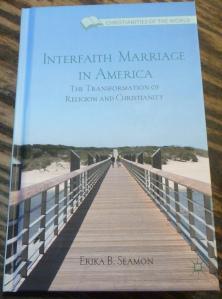
In case you missed it, here’s my most recent Huffington Post column…
Many books have characterized interfaith marriage as a challenge, a risk, a threat, or worse. Georgetown University’s Erika B. Seamon bring a new perspective to the topic in her recent book Interfaith Marriage in America: The Transformation of Religion and Christianity, part of a series entitled “Christianities of the World.” This important academic work chronicles the history of intermarriage, and the effects of contemporary interfaith marriages on religious institutions, when viewed through a Christian lens.
“Christians have been marrying non-Christians all over the globe for centuries,” Seamon writes. Of course, historically, it is not only Jews who objected to intermarriage: under Constantine in the fourth century, those who intermarried faced the death penalty. In medieval times, Christians were not allowed to dine with Jews, let alone marry them. And in 1222, an English deacon who converted in order to marry a Jewish woman was burned at the stake.
Seamon goes on to describe how Protestant reformers including Martin Luther and John Calvin helped to pave the way for greater acceptance. Luther said of intermarriage, “Pay no attention to the precepts of those fools who forbid it. You will find plenty of Christians—and indeed the greater part of them—who are worse in their secret unbelief than any Jew, heathen, Turk, or heretic.” As Seamon notes, “Luther did not just open the door to religious intermarriage; it is as if he came blazing right through the door with all his might.” She goes on to describe the resistance to interfaith marriage by both Jewish and Catholic religious leaders in the immigrant communities of America in the 19th and 20th centuries.
In order to explore contemporary interfaith marriage, Seamon draws on interviews with 40 intermarried people, conducted by a team of Georgetown students. (I should note that one of the couples belongs to my interfaith families community, IFFP.) The couples, she notes, describe how their marriages were “greatly enhanced not in spite of, but because of their religious differences.” From a Christian perspective, Seamon describes how, although they may not necessarily get married in the church or always baptize their children, “aspects of Christianity remain vital” to these families.
Seamon points out that theologians and religious authorities have sometimes inappropriately “projected secular identity” onto interfaith families. At the same time, they have disparaged what they saw as “syncretism” or reductive religious blending in these families. Instead, Seamon describes interfaith couples as “complex,” and as using “legal, theological and social freedom to creatively reformulate the role of religion in their lives.”
Seamon concludes that interfaith families are changing the religious landscape, creating what she calls the Interfaith Space. In short, she has discovered the world in which many interfaith families live, the world I chronicle in my blog and upcoming book. It is encouraging to note that this year, for the first time, the American Academy of Religion will have a Group at their national conference devoted to Interreligious and Interfaith Studies. Building on Seamon’s work, I hope that academia will continue to explore the intersection of interfaith families, religious pluralism, and interfaith dialogue.
“Interfaith marriages are the material representations of the shifting boundaries among religions and between religious and secular space,” Seamon writes. She concludes that scholars of Christianity can no longer ignore those of us living in this Interfaith Space. I would add that Jewish, Muslim, Buddhist, Hindu, Pagan and other religious scholars will find this book equally illuminating, and even essential.

